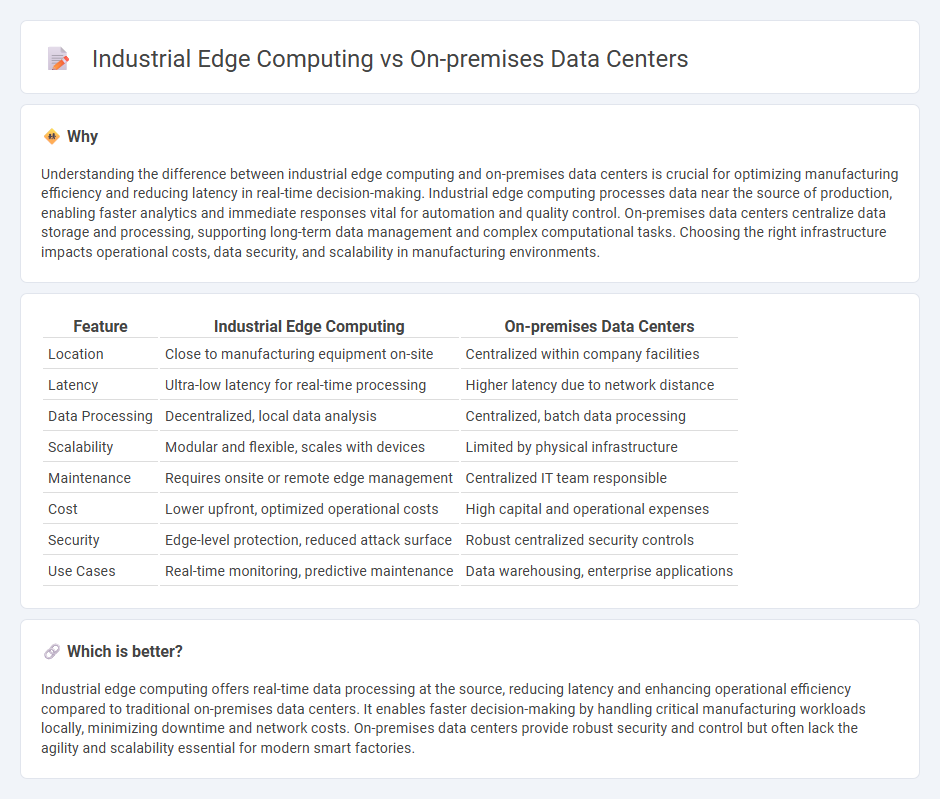
Industrial edge computing enables real-time data processing closer to manufacturing equipment, reducing latency and improving operational efficiency compared to traditional on-premises data centers that rely on centralized servers. This shift supports faster decision-making, enhances predictive maintenance, and optimizes supply chain management by leveraging IoT and AI technologies at the production site. Discover how integrating industrial edge solutions can transform your manufacturing operations.
Why it is important
Understanding the difference between industrial edge computing and on-premises data centers is crucial for optimizing manufacturing efficiency and reducing latency in real-time decision-making. Industrial edge computing processes data near the source of production, enabling faster analytics and immediate responses vital for automation and quality control. On-premises data centers centralize data storage and processing, supporting long-term data management and complex computational tasks. Choosing the right infrastructure impacts operational costs, data security, and scalability in manufacturing environments.
Comparison Table
| Feature | Industrial Edge Computing | On-premises Data Centers |
|---|---|---|
| Location | Close to manufacturing equipment on-site | Centralized within company facilities |
| Latency | Ultra-low latency for real-time processing | Higher latency due to network distance |
| Data Processing | Decentralized, local data analysis | Centralized, batch data processing |
| Scalability | Modular and flexible, scales with devices | Limited by physical infrastructure |
| Maintenance | Requires onsite or remote edge management | Centralized IT team responsible |
| Cost | Lower upfront, optimized operational costs | High capital and operational expenses |
| Security | Edge-level protection, reduced attack surface | Robust centralized security controls |
| Use Cases | Real-time monitoring, predictive maintenance | Data warehousing, enterprise applications |
Which is better?
Industrial edge computing offers real-time data processing at the source, reducing latency and enhancing operational efficiency compared to traditional on-premises data centers. It enables faster decision-making by handling critical manufacturing workloads locally, minimizing downtime and network costs. On-premises data centers provide robust security and control but often lack the agility and scalability essential for modern smart factories.
Connection
Industrial edge computing processes real-time data locally at manufacturing sites, significantly reducing latency and enhancing operational efficiency. On-premises data centers serve as centralized hubs that store and manage vast amounts of industrial data collected from edge devices, ensuring secure and reliable access. The integration of edge computing with on-premises data centers enables seamless data flow, optimized production monitoring, and faster decision-making in manufacturing environments.
Key Terms
Latency
On-premises data centers offer centralized processing with higher latency due to physical distance from edge devices, impacting real-time applications. Industrial edge computing processes data locally at or near the source, drastically reducing latency to milliseconds, essential for time-sensitive operations in manufacturing and automation. Explore how optimizing latency through edge computing enhances operational efficiency and decision-making in industrial environments.
Data sovereignty
On-premises data centers provide greater control over data sovereignty by ensuring all information is stored and processed within a specific geographic location, aligning with strict regulatory requirements. Industrial edge computing enables real-time data processing closer to the source while addressing latency and bandwidth limitations but may involve complex data governance policies due to distributed architectures. Explore the nuances of data sovereignty in these environments to optimize compliance and operational efficiency.
Scalability
On-premises data centers offer limited scalability due to physical space, hardware constraints, and significant upfront investment, making rapid expansion challenging. Industrial edge computing enables scalable deployment by processing data closer to the source, reducing latency and bandwidth costs while allowing flexible resource allocation across distributed sites. Explore how industrial edge computing can transform your scalability strategy and optimize operational efficiency.
Source and External Links
On-Premises Data Centers vs. Cloud Computing What is On-Premises Data Centers vs. Cloud Computing? - An on-premises data center is a group of servers you privately own and control, allowing full control of your infrastructure, unlike cloud computing which leases resources from a third party.
Top 10: Benefits of On-Prem - On-premises data centers are physical infrastructures owned and operated by the organization, offering total control, high security, and customization of hardware and data management within the business premises.
On-Premises Benefits - On-premises solutions provide continuous access to critical business data without internet dependency, enhanced regulatory compliance, better data tracing, reduced latency, and control over security protocols, which is essential for certain industries and global data laws.
 dowidth.com
dowidth.com